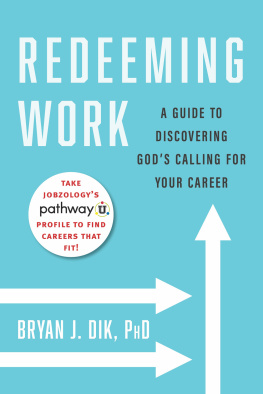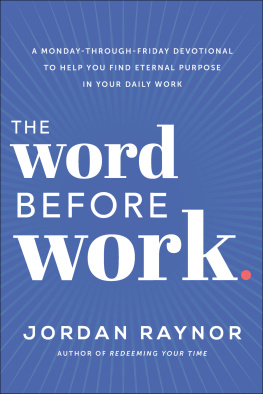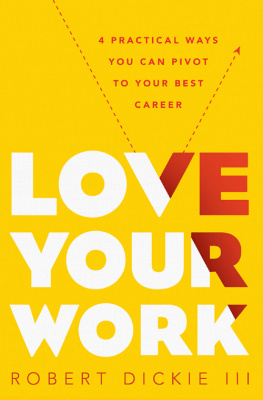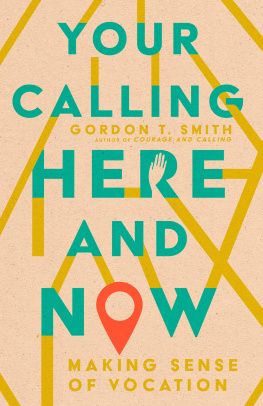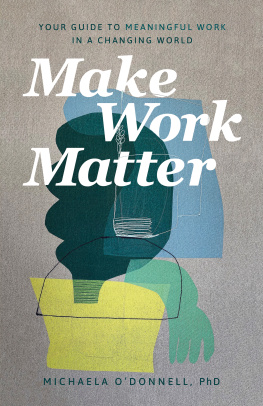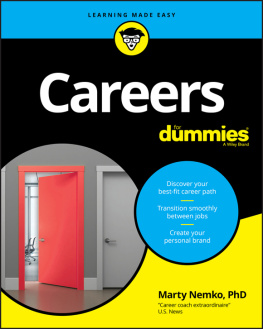
Acknowledgments
W RITING A BOOK often feels like a solitary activity, but anyone who has done it will tell you it takes a village to pull off. That was certainly true for this book. Thanks are due first of all to the team at Templeton PressSusan Arellano, Angelina Horst, Dan Reilly, and Trish Vergilio. They once again managed to combine vision, encouragement, patience, and expert editorial guidance in life-giving ways. I am also indebted to several friends and colleagues who offered extremely valuable, generative feedback on various drafts of the manuscript. Andy Tix especially was a workhorse in this regard. If he wasnt such an incredible teacher, he could easily find work as an editor, such are his gifts. Others who provided this assistance were Jack Dik, Terry Gray, Scott Filkin, Kaitlyn Reed, Amy Van Guilder Dik, and Paige Wiley. I am also indebted to the kingdom workers who allowed me the honor of sharing their stories in these pages.
I am blessed to work with a mighty team at jobZology. I am especially grateful to my cofounders Travis Hevelone, Kurt Kraiger, and Eric Leftwich, whose support of my vision for this project has meant the world. I am grateful to serve on the psychology faculty at Colorado State University as well, where I have the freedom to take on projects like this one. Thanks are due to my helpful colleagues there, as well as my PhD students who more than once had to wait longer than they should have for comments on their drafts because I needed to hit a deadline for this book. I am grateful as well for ongoing encouragement from my friends and frequent collaborators Ryan Duffy and Michael Steger, and to the broader community of calling and meaningful work researchers, faith and work scholars, and Society for Vocational Psychology colleagues, all of whom I value although will not name, lest I inadvertently miss anyone.
I owe a special debt of gratitude to Andrew and Heather Storteboom and Craig and Carolyn Hanson, who provided the sacred space needed for critical sessions of deep work. This book would never have come together, at least not in a timely way, without their kind hearts and generous spirits. I wish to thank my brothers and sisters in Christ at Immanuel Christian Reformed Church as well, especially our small group, who regularly checked in and offered support and prayer. Jo-Ida Hansen and Wayne Joosse continue to offer mentoring and friendship, and Craig Bierenga, Chris Kuipers, Matt Schaap, Matt Schlimm, and Zach Vandenberg are always on standby, which I have never taken for granted.
I am thankful to all the Van Guilders, to Luke LaBlance for checking on my progress, to the VandenBosch and Dukes families, and to my parents, Jack and Sandra, whose listening ears and constant encouragement have always given me a boost. Finally and most of all, thank you to my beautiful and brilliant wife, Amy, for her wisdom and sacrificial love, and to our fun-loving boys, Eli, Silas, Abram, and Jasper. My life is so much richer because you five are in it, and I thank God for you every day.

Notes
INTRODUCTION
.David W. Miller, PhD, director of Princeton Universitys Faith and Work Initiative, even suggests we are living in the Faith at Work Era. See David W. Miller, God at Work: The History and Promise of the Faith and Work Movement (New York: Oxford University Press, 2007).
.Pete Hammond, R. Paul Stevens, and Todd Svanoe, The Marketplace Annotated Bibliography: A Christian Guide to Books on Work, Business, and Vocation (Downers Grove, IL: InterVarsity Press, 2002).
CHAPTER 1
.Portions of this summary are adapted from an article I wrote for The Banner, Where in the World (of Work) Have All the Reformers Gone? January 18, 2011, https://thebanner.org/departments/2011/01/where-in-the-world-of-work-have-all-the-reformers-gone.
.Social psychologist Crystal Park suggests that people experience positive health and well-being when their global worldview beliefs harmonize with their day-to-day experiences in life, including at the workplace. See Crystal L. Park, Religious and Spiritual Aspects of Meaning in the Context of Work Life, in Psychology of Religion and Workplace Spirituality, ed. Peter Hill and Bryan Dik (Charlotte, NC: Information Age, 2012), 2542.
commentators suggest that N. T. Wright was the first to illustrate the story of Scripture using the model of a play. His approach identified five acts: creation, fall, Israel, Jesus, and the rest of the New Testament. See N. T. Wright, How Can the Bible Be Authoritative? Vox Evangelica 21 (1991), 732. Others have described it as chapters in a book (e.g., Whelchel) to the same effect. One might also describe the Bible as a drama with six acts: creation; fall; Gods covenantal resolution to crush sin; Jesuss life, ministry, death, and resurrection; the era of witness by the church; and restoration/consummation/renewal, as do Michael Goheen and Craig Bartholemew, The True Story of the Whole World (Grand Rapids: Faith Alive, 2009). Hugh Whelchel, All Things New: Rediscovering the Four-Chapter Gospel (McLean, VA: Institute for Faith, Work & Economics, 2016).
.Some of the language in this summary of the Four-Act Story, and in the reasons a Two-Act Story falls short, borrows from a helpful booklet by Hugh Whelchel, All Things New: Rediscovering the Four-Chapter Gospel (McLean, VA: Institute for Faith, Work & Economics, 2016).
.Christians dont agree on how creation unfolded, but they agree that God is the creator. The curious but uninitiated on this debate might try as a starting point J. B. Stump, ed., Four Views on Creation, Evolution, and Intelligent Design (Grand Rapids: Zondervan, 2017).
.Amy Sherman, Kingdom Calling: Vocational Stewardship for the Common Good (Downers Grove, IL: IVP Books, 2011), 78, 79.
.Short-term missions usually have a positive impact on the people who serve. They provide a potentially life-changing way to bond with other believers in learning about what people experience in other communities, sometimes in other parts of the world. That said, there is substantial debate about their long-term impact on communities that are being served, especially when factoring in the costs of such trips and the alternative options for using those resources to support more sustainable local efforts in the locales that receive them. See Steve Corbett and Brian Fikkert, When Helping Hurts: How to Alleviate Poverty Without Hurting the Poor... and Yourself, (Chicago: Moody Publishers, 2014), but also Tracy Kuperus and Roland Hoksbergen, When Helping Heals (Grand Rapids: Calvin College Press, 2017).
.Sharing our faith is an important response to the great commission, our command from Jesus to make disciples of all nations (Matthew 28:19).
As Ryan Duffy and I described in our book Make Your Job a Calling, there is at least anecdotal evidence that some people in extremely difficult circumstances can nevertheless derive meaning from the work, but this in no way lets employers off the hook from their responsibility to provide decent work that affords adequate compensation, hours that afford free time and rest, and a physically and psychologically safe work environment.
.An excellent interview with Jen is available at the All Things New podcast: https://summitview.com/blog/faith-work-jen-dekorte/.
.Romans 8:22: We know that the whole creation has been groaning as in the pains of childbirth right up to the present time.
.The Bible describes itself as Gods inspired, authoritative word, useful for teaching, rebuking, correcting, and training in righteousness, so that the servant of God may be thoroughly equipped for every good work (2 Timothy 3:16).
Next page
